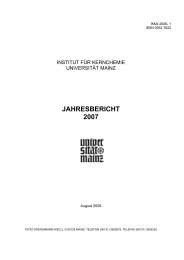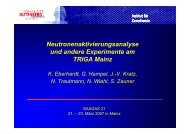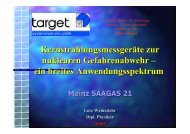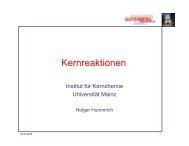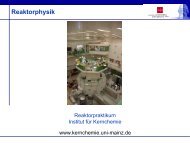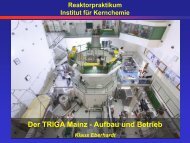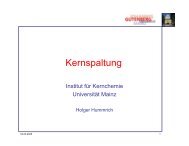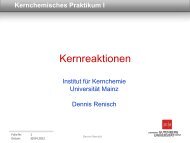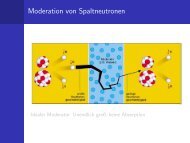institut für kernchemie universität mainz jahresbericht 2009
institut für kernchemie universität mainz jahresbericht 2009
institut für kernchemie universität mainz jahresbericht 2009
Create successful ePaper yourself
Turn your PDF publications into a flip-book with our unique Google optimized e-Paper software.
Resonance Ionization Spectroscopy (RIS) on 237 Np<br />
N. Stöbener 1 , T. Gottwald 2 , S. Raeder 2 , G. Passler 2 , T. Reich 1 , N. Trautmann 1 , K. Wendt 2<br />
1 Institut <strong>für</strong> Kernchemie, Johannes Gutenberg-Universität, D-55128 Mainz, Germany;<br />
2 Institut <strong>für</strong> Physik, Johannes Gutenberg-Universität, D-55128 Mainz, Germany<br />
Introduction: 237 Np (T1/2 = 2.14�10 6 a) will be a main<br />
contributor to the radiotoxicity of spent nuclear fuel for<br />
periods exceeding one million years. Therefore, research<br />
on the geochemical properties and the migration<br />
behaviour of neptunium is important for the safety<br />
assessment of proposed nuclear waste repositories. Since<br />
the concentrations of neptunium in the aquifer in case of<br />
a leakage of a repository are expected to be less than<br />
10 -10 mol�L -1 , very sensitive analytical methods are<br />
needed for detection and quantification of<br />
237 Np.<br />
Previous studies by J. Riegel et al. 1 demonstrated the<br />
application of resonance ionization mass spectrometry<br />
(RIMS) with dye lasers for ultratrace analysis of<br />
neptunium. Meanwhile, this setup has been replaced by a<br />
more reliable all solid state laser system consisting of<br />
three titanium-sapphire (Ti:Sa) lasers pumped jointly by<br />
a Nd:YAG laser. Since these lasers are not capable of<br />
producing light of the wavelengths used previously,<br />
resonance ionization spectroscopy (RIS) was applied to<br />
identify high lying energy levels and autoionizing states<br />
which can be used for the development of three step<br />
excitation schemes for RIMS with Ti:Sa lasers.<br />
Experimental: The laser setup used for RIS consisted of<br />
three Ti:Sa lasers. While two of theses lasers contained<br />
lyot filters and an etalon and were operated at fixed<br />
wavelengths, the third Ti:Sa laser was equipped with an<br />
optical grading and was tuneable continuously over a<br />
broad wavelength range. Blue laser light, which is<br />
necessary for the first excitation step of the neptunium<br />
atoms into levels with an energy of about 25000 cm -1 ,<br />
was produced by frequency doubling of the light of one<br />
Ti:Sa laser in a BBO crystal. Samples for RIS were<br />
prepared by applying about 10 14 atoms of 237 Np as<br />
neptunium(V) nitrate solution onto a small piece of<br />
zirconium foil. After heating to dryness, the samples<br />
were placed in a graphite furnace. During resistive<br />
heating of the furnace, the neptunium ions were reduced<br />
by the zirconium and an atomic beam of neptunium was<br />
emitted. These neptunium atoms were subsequently<br />
ionized by light from the Ti:Sa lasers; the ions formed<br />
were detected with a quadrupole mass spectrometer.<br />
Since many suitable energy levels are known for the first<br />
excitation step 2 , one laser was operated at different fixed<br />
wavelengths to populate several of these odd parity<br />
states. For excitation of unknown high lying energy<br />
levels, the continuously tuneable grating assisted laser<br />
was scanned and NIR light of the third Ti:Sa was used<br />
for non-resonant ionization of the highly excited atoms.<br />
Search for autoionizing states was performed similarly<br />
by populating several of the newly identified high lying<br />
levels with light from a laser operating at a fixed<br />
wavelength and scanning of the grating assisted Ti:Sa<br />
laser.<br />
- C1 -<br />
Results: Numerous high-lying energy levels and<br />
autoionizing states of neptunium have been identified (s.<br />
fig. 1 and 2). Also, several excitation schemes suitable for<br />
resonance ionization mass spectrometry with three Ti:Sa<br />
lasers have been developed. Two examples are shown in<br />
fig. 3. Saturation of the optical transitions is usually<br />
possible with moderate laser power for the first two<br />
excitation steps.<br />
Figure 1. Spectrum of high lying levels of 237 Np accessible by<br />
resonant excitation from an energy level at 24798 cm -1<br />
Figure 2. Spectrum of autoionizing states excited from a high<br />
lying energy level at 37789 cm -1<br />
Figure 3. Two possible schemes for resonant excitation and<br />
ionization of 237 Np populating autoionizing states above the<br />
ionization potential at 50535 cm -1 .<br />
References<br />
[1] J. Riegel et al., Appl. Phys. B 56 (1993), 275-280<br />
[2] J. Blaise, J.-F. Wyart, Selected Constants, Energy Levels and<br />
Atomic Spectra, Tables Internationales de Constantes,<br />
Université P. et M. Curie, Paris 1992<br />
Acknowledgement<br />
This work was financially supported by DFG graduate school 826<br />
“Spurenanalytik von Elementspezies”.



